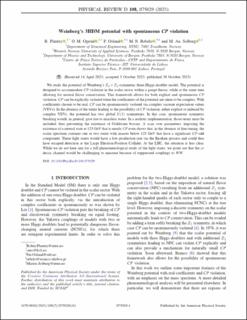| dc.contributor.author | Plantey, Robin Maurice Yves | |
| dc.contributor.author | Øgreid, Odd Magne | |
| dc.contributor.author | Osland, Per | |
| dc.contributor.author | Rebelo, Margarida N. | |
| dc.contributor.author | Solberg, Rolf Marius Aase | |
| dc.date.accessioned | 2023-11-29T08:10:34Z | |
| dc.date.available | 2023-11-29T08:10:34Z | |
| dc.date.created | 2023-10-30T15:49:28Z | |
| dc.date.issued | 2023 | |
| dc.identifier.citation | Physical Review D. 2023, 108 (7), . | en_US |
| dc.identifier.issn | 2470-0010 | |
| dc.identifier.uri | https://hdl.handle.net/11250/3105143 | |
| dc.description.abstract | We study the potential of Weinberg’s Z2 × Z2-symmetric three-Higgs-doublet model. The potential is designed to accommodate CP violation in the scalar sector within a gauge theory, while at the same time allowing for natural flavor conservation. This framework allows for both explicit and spontaneous CP violation. CP can be explicitly violated when the coefficients of the potential are taken to be complex. With coefficients chosen to be real, CP can be spontaneously violated via complex vacuum expectation values (VEVs). In the absence of the terms leading to the possibility of CP violation, either explicit or induced by complex VEVs, the potential has two global Uð1Þ symmetries. In this case, spontaneous symmetry breaking would, in general, give rise to massless states. In a realistic implementation, those terms must be included, thus preventing the existence of Goldstone bosons. A scan over parameters, imposing the existence of a neutral state at 125 GeV that is nearly CP even shows that, in the absence of fine-tuning, the scalar spectrum contains one or two states with masses below 125 GeV that have a significant CP-odd component. These light states would have a low production rate via the Bjorken process and could thus have escaped detection at the Large Electron-Positron Collider. At the LHC, the situation is less clear. While we do not here aim for a full phenomenological study of the light states, we point out that the γγ decay channel would be challenging to measure because of suppressed couplings to WW. | en_US |
| dc.language.iso | eng | en_US |
| dc.publisher | American Physical Society | en_US |
| dc.rights | Navngivelse 4.0 Internasjonal | * |
| dc.rights.uri | http://creativecommons.org/licenses/by/4.0/deed.no | * |
| dc.title | Weinberg’s 3HDM potential with spontaneous CP violation | en_US |
| dc.title.alternative | Weinberg’s 3HDM potential with spontaneous CP violation | en_US |
| dc.type | Peer reviewed | en_US |
| dc.type | Journal article | en_US |
| dc.description.version | publishedVersion | en_US |
| dc.source.pagenumber | 18 | en_US |
| dc.source.volume | 108 | en_US |
| dc.source.journal | Physical Review D | en_US |
| dc.source.issue | 7 | en_US |
| dc.identifier.doi | 10.1103/PhysRevD.108.075029 | |
| dc.identifier.cristin | 2190164 | |
| cristin.ispublished | true | |
| cristin.fulltext | postprint | |
| cristin.fulltext | original | |
| cristin.qualitycode | 1 | |

